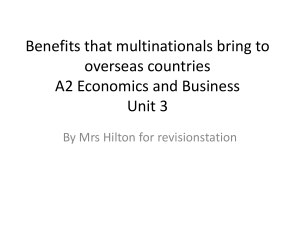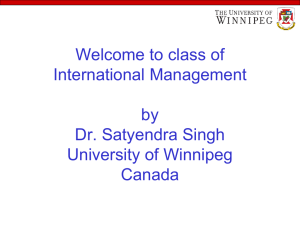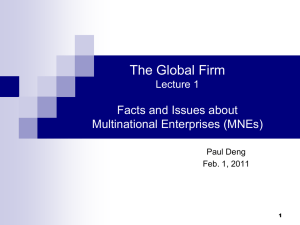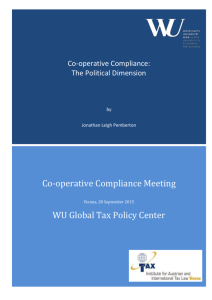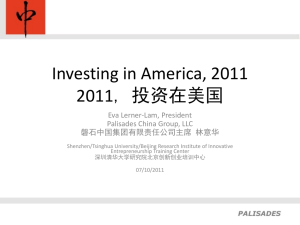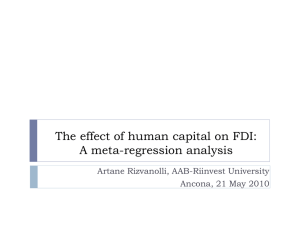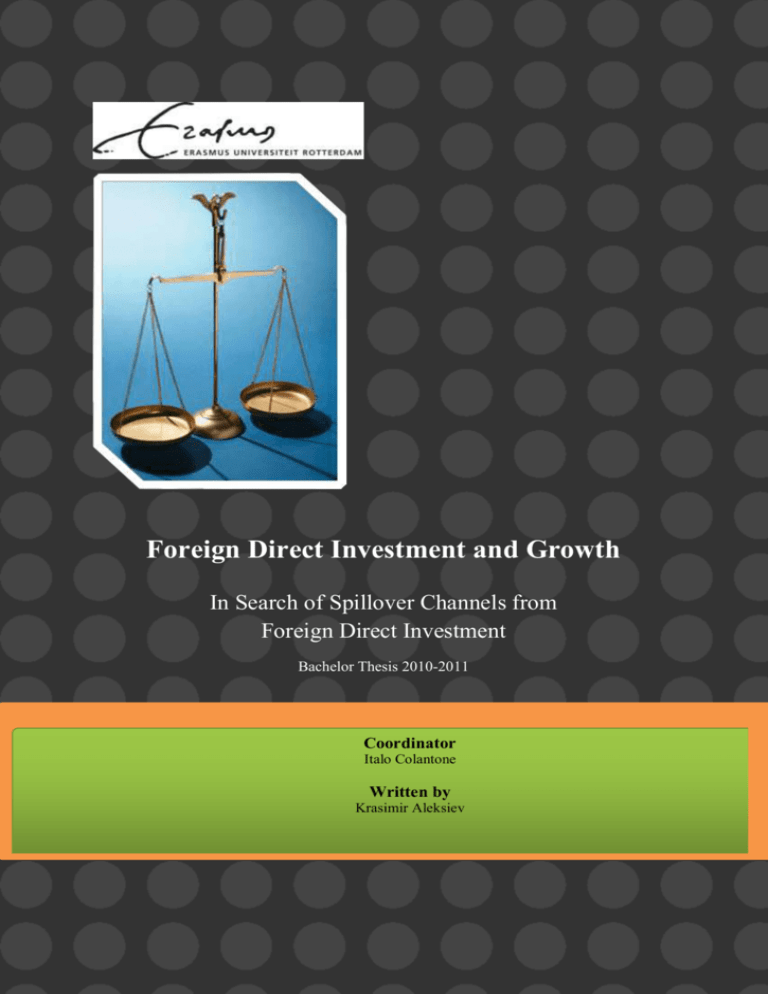
Foreign Direct Investment and Growth
In Search of Spillover Channels from
Foreign Direct Investment
Bachelor Thesis 2010-2011
Coordinator
Italo Colantone
Written by
Krasimir Aleksiev
i
Rotterdam School of Economics, Erasmus University
International Bachelor Economics and Business Economics
Bachelor Thesis 2010 – 2011
Foreign Direct Investment and Growth
In Search of Spillover Channels from Foreign Direct Investment
March 12, 2011
Coordinator
Italo Colantone
By
Krasimir Ilianov Aleksiev
aleksiev_krasimir@yahoo.com
314969
i
Abstract
The main question of interest in the following research paper is the effect of FDI to economic
growth in the host countries. The motivation for writing the paper originates from the inability
of the academia to establish a clear and straightforward view for the role of FDI for economic
growth.
In providing an adequate and sufficient analysis to the problem, several key steps are to
implement. First, the paper provides a short descriptive overview of the main determinants for
FDI. Second, the standard Solow growth model is presented aiming at clarify the main
vehicles for economic growth. Third, a detailed analysis of the activities of the MNEs is
included. In its nature, this is a multi-dimensional approach which focuses on the changes in
productivity, labor and potential spillover effects originating from the MNEs’ activities in the
host economies.
From the findings in the paper, it can be concluded that the activities of the MNEs have a
beneficial effect for fostering economic growth in the host countries. Evidence suggests that
MNEs’ activities enhance growth through all potential channels- capital, labor and
productivity. The existence of a number of spillover effects additionally confirms positive role
of that MNEs have for economic growth in the host countries.
ii
Table of Contents
Introduction .............................................................................................................................. 1
Problem Statement ............................................................................................................... 2
Literature Review................................................................................................................. 2
Determinants of FDI ................................................................................................................ 5
General Framework ............................................................................................................. 5
Impact of FDI Determinants ................................................................................................ 5
OLI Model ........................................................................................................................... 8
Growth Theory ......................................................................................................................... 9
The Model ............................................................................................................................ 9
Productivity............................................................................................................................. 13
Conceptual Framework ...................................................................................................... 13
Unconditional Approach .................................................................................................... 13
Conditional Approach ........................................................................................................ 14
Total Factor Productivity Approach .................................................................................. 15
Labor ....................................................................................................................................... 17
Skills Improvements .......................................................................................................... 17
Wages and Mobility Spillovers .......................................................................................... 17
Labor Market Transformations .......................................................................................... 18
Spillovers ................................................................................................................................. 20
Empirical Evidence ............................................................................................................ 21
Conclusion ............................................................................................................................... 24
Appendix ....................................................................................................................................I
Bibliography ........................................................................................................................... VI
iii
Introduction
The last 25 years have been marked by a rapid expansion of the activities of the multinational
enterprises (MNE) measured by the flows of foreign direct investment (FDI). Figure 1 shows
the dramatic increase of FDI which substantially outperformed the rise in the global output
and trade. A quick look at the data shows us that the global GDP expanded at an average
annual pace of 2.5% in the period between 1985 and 2000. Meanwhile, for the same period
trade increased at an average of 5.6% annually and FDI flows sky-rocketed with 17.7%. The
data dramatically contrasts when compared with the pre 1985 period when FDI increased side
by side with GDP and trade (Navaretti & Venables, 2004).
The facts show that FDI mainly originate from the advanced countries. In the recent years the
share of the developing countries as a source of FDI significantly increases but still the lion’s
part belongs to the EU countries, USA and Japan which account for 80-90% of the total FDI
outflows. Even measured as a percentage of GDP, the developed countries still account for
the great majority of FDI outflows (see fig 2).The structure of the recipient countries suggests
that most of the FDI goes to the developed countries, too. The share of some developing
regions and especially Asia and Latin America, however, shows a consistent increase over
time (see fig. 3), with the exception of some adverse episodes such as the Asian crisis of
1997/98 (Navaretti & Venables, 2004).
As can be seen from the abovementioned statistical data, the role of FDI is inevitably
increasing in a rapidly globalizing world. The polemics for the role of FDI in the host
economies have been unusually tense lately. Some of the analysts argue that the activity of
MNEs is beneficial by bringing inflows of capital and technology, as well as creating job
opportunities in the host countries. Others claim, however, that FDI inflows are jeopardy to
the recipient economies because they create economic instability, threaten the existence of the
local firms and undermine the local governments (Navaretti & Venables, 2004).
Apparently, both parties in the discussion have their legitimate arguments. Nevertheless, the
aim of this paper is far from being a referee in the discussion. Bill Gates said once:” No one
gets to vote on whether technology is going to change our lives”. By using this quote as a
metaphor, similar parallels can be made in regards to FDI. No doubt, FDI have become an
evitable part of today’s globalized world and no one has the power to stop this process.
1
Therefore, it is essential that the effects of FDI to the host economies be thoroughly and
independently evaluated- not an easy task, having in mind the polarity of the majority of
opinions.
Problem Statement
The aim of this research paper is to analyze, if FDI are beneficial and lead to economic
growth in the host economies. The answer of this question insists the accomplishment of two
main tasks. First, the determinants of economics growth should be stated and clarified by
presenting an appropriate economic growth model. Second, the activities of the MNEs in the
host countries should be assessed accordingly. The attention should be paid on the direct
impact that the MNEs’ activities have to the different economic growth vehicles- capital,
labor and technological progress. Moreover, in being objective about the role of MNEs, it is
of particular importance that the potential spillover effects, originating from their activities, be
properly evaluated.
Literature Review
A considerable amount of literature has been dedicated recently to the topic of FDI and its
impact on growth in the host countries. A brief look at the existing knowledge in this field
suggests that a clear consensus about the positive role of FDI to economic growth is far from
being reached. Generally, researchers are split into two separate groups with polar opinions on
the issue. Since the point of the thesis paper is to analyze the role of FDI on growth and the
specific spillover channels, we aim at being objective by including as wide range of scientific
findings as possible. Therefore, this chapter of the thesis provides an overview of some
important research papers in relation to the topic of FDI and growth, most of which are
included in the thesis itself.
In “Foreign Direct Investment, Growth and Income Inequality in Less Developed Countries”
Kevin Sylwester makes a cross sectional analysis for a group of developing countries between
1970 and 1989. Sylwester finds strong evidence that FDI is a growth promoting factor in the
observed countries (Sylwester, 2005).
A similar conclusion is reached in “Foreign Direct Investment-Growth Nexus: A review of
recent literature” by Ilhan Ozturk. The author recognizes a positive relationship between FDI
2
and economic growth. Moreover, the evidence suggests that FDI promotes growth via three
distinguished channels- capital formation, technology transfer and human capital
enhancement (Ozturk, 2007).
In “Does Foreign Direct Investment Help Emerging Economies” by the Federal Reserve Bank
of Dallas it is found that between FDI and growth exists strong positive relationship. The
author of the paper Anil Kumar suggests that each percentage point increase in FDI-to-GDP
ratio leads to a percentage point cumulative increase in the long-run growth rate (Kumar,
2007).
The positive role of FDI for growth is also confirmed by Luiz R. de Mello Jr. in the study
“Foreign direct investment in developing countries and growth: A selective survey”. The
author, however, distinguishes two separate cases by examining the effect of FDI in countries
with export orientation and import substitution profiles. The conclusion is that trade regime
indeed matters and FDI among the group of export orientation countries leads to much higher
economic growth (de Mello Jr., 1997).
It is worth mentioning that a number of influential researchers oppose to the prevailing
opinion that FDI leads to economic growth. Maria Carcovic and Ross Levine in “Does
Foreign Investment Accelerate Economic Growth?” provide a dynamic panel estimation of a
group of industrialized and developing countries between 1960 and 1995 by applying
standard, as well as, reversed causality techniques. The paper does not find clear evidence
that FDI is a growth enhancing factor. The same conclusion is found even when controlling
for some specific factors, such as the level of human capital, income per capita in the
domestic economy, the degree of sophistication of domestic financial markets and the degree
of trade openness (Carcovic & Levine, 2002).
A similar viewpoint is supported by Magnus Blomstrom and Ari Kokko in “The Impact of
Foreign Investment on Host Countries: A Review of the Empirical Evidence”. The authors
suggest that s FDI has only limited effect on growth and such an effect greatly depends on
country’s specifics, as well as, the industries where FDI is concentrated (Blomstrom &
Kokko, 1997).
In “Foreign Direct Investment and Growth: Does the Sector Matter” Laura Alfaro elaborates a
cross-section analysis on 47 countries between 1980 and 1999 in order to evaluate the role of
FDI to economic growth. The author reaches quite ambiguous conclusions. Indeed, FDI
3
results in higher growth in the manufacturing sector. Its effect on growth in the primary
sector, however, tends to be even a negative one. The evidence from the service sector is quite
unclear and a positive relationship between FDI and growth is not found to hold at all (Alfaro,
2003).
4
Determinants of FDI
General Framework
In general, there are two main reasons why a company wants to become a multinational one.
The first reason is to better serve the local market and the second one is to get lower cost
inputs. When FDI is made in order to serve the local market, it is often called “horizontal”.
Such an investment is usually associated with building of duplicate production facilities
which aim at serving the local market. By doing this, the MNEs achieve significant cost
reductions by eliminating tariffs and transportation costs as well as reaching proximity to the
local markets. Horizontal FDI are usually undertaken in countries with relatively large
markets because the fixed costs per unit of production in those markets are significantly
lower. Moreover, countries with large markets tend to have much fiercer domestic
competition which drives the prices down and makes the imported goods uncompetitive due
to the extra transportation and tariff costs (Lim, 2001).
The second reason for FDI is when a MNE is searching for lower input costs. It is often called
“vertical” or “production-cost minimizing” FDI. This type of investment usually involves
moving certain segments of the production process in countries with lower labor costs or
available raw materials and commodities necessary for the production. Vertical FDI are often
export oriented typically to the MNE’s home countries and tend to be unaffected by the size
of the host market. Generally, vertical FDI are preferred when the different parts of the
production process have different input requirement and input prices vary among the
countries (Lim, 2001).
Impact of FDI Determinants
A list of factors are found to affect to a different extend the FDI inflows. These factors can be
summarized as market size, distance/transportation costs, agglomeration effects, factor costs,
fiscal incentives, investment climate, trade barriers/openness, economic integration as well as
institutional and political stability. Typically, most of the factors are valid for all types of FDI.
In some cases, however, certain factors may affect one type of FDI more than the other (Lim,
2001).
5
Friendlier business/investment environment is probably one of the most important
prerequisite for FDI attraction. There are a number of factors that influence the business
environment in the host country. First of all, political and macroeconomic stability are
assumed to be key ingredients that are making a country attractive for FDI. Investors prefer
politically stable countries. It also prefers countries with predictable macroeconomic policies
that are demonstrating accountability. Secondly, the role of the institutional framework for the
business environment can be of considerable importance. A well built and functioning
judiciary system which guarantees property rights, contracts enforcement, etc. is essential in
creating friendly business environment. Moreover, factors such as low corruption level, less
bureaucracy and regulatory hurdles contribute to FDI, too. All the mentioned factors in
regards to the business environment have a significant influence on both, horizontal and
vertical FDI (Lim, 2001).
Government policies are of particular importance in attracting FDI, as well. In order to boost
employment levels and growth, the official authorities often introduce specific incentives that
enhance the MNEs ability to undertake investments in the host country. A set of specific
government policies exists, including subsidies, tariffs, taxes, privatization policy, as well as
regulatory regime. On the one hand, empirical evidence shows that the higher tariffs and taxes
are, the higher the cost of the MNE is, which consequently results in decreased profitability
and lower FDI inflow (Tsoukis, Agiomirgianakis & Biswas, 2004). On the other hand,
providing grants and subsidies, as well as, tax rebates and exemptions tend to boost foreign
investment in the host country (de Mello Jr., 1997).
The volume and type of FDI inflows are also influenced by some scale factors. The most
important one among them is the size of the host country’s domestic market. A large domestic
market, combined with robust growth prospects, can favorably influence the foreign
investors’ decisions in respect to relocation of production or engaging in export oriented
production facilities in the host country. Specifically, the main advantage of the large market
size is translated in lower fixed costs per unit of production (de Mello Jr., 1997).
The cost structure of the MNE affiliates is another important aspect for the FDI inflows.
Sometimes, production relocation is associated with significant sunk costs undertaken by the
MNE. If the host country, however, offers sufficiently minimized factor costs (wages and
capital expenditures, for instance) the negative effect of the sunk costs can be completely
neutralized, thus making the investment attractive. Moreover, the degree of monopolistic
6
competition is of particular importance in MNE’s ability to cover their sunk costs and prevent
the entry of other companies which usually leads to retaining of significant market share (de
Mello Jr., 1997).
A key determinant for attracting FDI is the trade regime of the host country and its degree of
openness. In import substitution (IS) regime countries MNEs are often facing difficulties in
penetrating the home country’s markets due to government subsidies or other types of
protectionist measures over indigenous and “strategic” industries (de Mello Jr., 1997). The
lesser degree of openness among IS countries, however, creates some incentives for
undertaking horizontal FDI which usually aim at getting behind tariffs (Lim, 2001). Countries
with export promotion (EP) regimes and higher degree of openness tend to be generally more
successful in attracting FDI due to the absence of widespread protectionist practices.
Additionally, the EP countries are trading much more than the IS ones. Logically, FDI is
expected to take place once there is significant trade between the foreign investor and the host
country which justifies the advantageous production relocation decision in the case with
vertical FDI (de Mello Jr., 1997).
The net effect of transportation costs on FDI is quite uncertain. On one hand, if the costs of
market access through exports are high, then horizontal FDI actually becomes more attractive
simultaneously with the increase of the distance between the home and the host economy. In
this case MNEs prefer to shift their production facilities directly to the host countries instead
of trying to ineffectively penetrate the market by costly exports. On the other hand, the
existence of large transportation costs can substantially discourage vertical FDI. In their
nature vertical FDI are export oriented and shipping costs present a significant part of their
cost structure (Lim, 2001).
Both, horizontal and vertical FDI tend to cluster in certain locations. This condition is often
referred as “agglomeration”. In its nature agglomeration is perceived to have a positive effect
on FDI. Its existence is often seen as a signal and proof to new potential investors that the host
country offers favorable economic and business conditions. There are several key factors
affecting agglomeration, such as the state of the host country’s infrastructure, the degree of
industrialization as well as capital stock accumulation (Lim, 2001).
Economic integration is another factor that influences FDI. Participating in a free trade area or
a customs union is of importance because it usually leads to the elimination of many trade
barriers and improving market accessibility by allowing “outside” companies to invest in the
7
integrated regional bloc. Once an “outside” company enters the common free trade region,
then it has an access to all the countries from the bloc. Economic integration leads to the
existence of much bigger common markets that translates in substantial fixed costs savings by
the MNEs (Motta & Norman, 1993).
OLI Model
An alternative approach to look at the FDI determinants is to consider the ownership-locationinternalization (OLI) model. The model, also known as an eclectic paradigm theory, is
published in 1980 by Dunning. In its sense the OLI assesses the different forms of market
entry of an international organization according to three basic categories of advantagesownership, location and internalization. The abovementioned categories of advantages are
particularly referring to FDI and the activities of the MNEs, as well (Dunning, 2001). In more
details, the advantages can be as follows:
Ownership advantages occur when companies of one nationality possess competitive
advantages over the companies of another nationality in supplying certain markets.
These advantages are usually happening due to the fact that the MNEs are equipped
with certain assets that in shortage to the domestically owned companies. Competitive
advantage can occur, also, as a result of better management skills, enhanced cross
border activities coordination or economies of scale.
Location advantages may result from a set of different factors, such as low wages, the
availability of specific raw materials, special tax regimes or tariffs that make the
multinational companies eager to invest in the regions that possess the
abovementioned competitive advantages.
Internalization advantages are advantages that usually emerge when the production
process takes place through partnership agreements such as joint ventures or licensing
(Twomey, 2000).
It will not be wrong to say that the nature of the OLI model is to provide a map that is often
used by the international companies. If the OLI advantages are in place, the companies often
choose to undertake FDI abroad instead of exporting. Therefore, despite its imperfections, the
OLI model can be used as a guide that correctly classifies the FDI determinants in one single
place.
8
Growth Theory
This chapter aims at providing the thesis with a strong theoretical framework in connection to
economic growth and its determinants. By understanding what drives growth in the short- and
long- run, it will be much easier to identify the impact that FDI has on the different growth
determinants and identify potential spillover effects.
The starting point of this analysis is the construction of a production function. In this case,
Solow’s neo-classical model of economic growth will be used as a basis of the discussion.
The choice of this model is dictated by its wide applicability, simplicity, and ability to stand
the test of time.
It is worth mentioning, however, that the neo-classical growth model has its significant
shortcomings. The major one is the consideration that the long-term growth can only result
from changes in technological progress and labor/demographic force growth, which are both
considered as exogenous. FDI can affect output growth only in the short-term. In the longterm the recipient economy would always converge to its steady-state growth level due to the
diminishing returns of the capital inputs, as if FDI had never taken place. Therefore, the only
vehicle for growth-enhancing FDI would be through permanent technological improvement.
Moreover, the neo-classical growth model suggests that government policies have an effect
only in the short-term, and the results from FDI-promoting policies would be short lived (de
Mello Jr., 1997).
The Model
First of all, it should be noted that through this text growth will be defined as “the steady
increase of aggregate output over time” (Blanchard, 2006). It is assumed that output is
defined by two factors of production – capital and labor and their relation can be explained by
the production function
[1]
Y = F(K, L)
In the above equation Y is aggregate output, K is capital and L is labor. Solow argues that in
the theory of growth it is natural to assume constant returns to scale, which is implied in the
9
production function above. (Solow, 1956) In other words, L, or the number of workers in the
economy, has a direct effect on output, so other things being equal, an increase in labor leads
to an increase in output. However, it is important to mention that in this model constant
returns to scale are effective only if both factors increase by the same multiplier. So in the
case of an increasing L, given K, the returns to scale will be in fact decreasing (Blanchard,
2006) (Solow, 1956).
In Solow’s model of economic growth the assumption of equality between output and income
is kept, so they can be interchangeably used and denoted by Y. With that in mind, it can be
said that at any moment of time, part of this income is consumed and the rest of it is saved and
invested. Therefore, sY signifies the part of output that is saved, assuming a constant
propensity to save given by the factor s. Denoting the stock of capital which is accumulated
over time by K, the net investment can be defined as the rate of increase of K over time or
dK/dt = Ќ. This leads to the following equation:
[2]
Ќ = sY
Combining equations [1] and [2] gives:
[3]
Ќ = sF(K, L)
Assuming that labor force grows (or shrinks) by a constant n, the model can be refined by
substituting L(t) with L0ent so equation [3] is rewritten as:
[4]
Ќ = 𝑠𝐹(𝐾, 𝐿0 𝑒 𝑛𝑡 )
By making these changes one should bear in mind that the conditions of full employment are
constantly kept so that in [4] L stands for the total available labor supply. The equation reveals
the changes in capital stock accumulation in time, so that by inserting the variable K(t) and
adjusting for the above given assumptions and restrictions the time path of capital stock can
be built. Combined with the time path of labor force, the production function in equation [1]
can be used in order to compute the time path of output, which essentially is the required
information to assess growth, earlier defined as “the steady increase of aggregate output over
time”. The amount of savings can be measured by the propensity to save applied to the output
for the period in question. The model is very straightforward and as it does not include
technological progress, growth comes only from the static increase of labor supply and
10
accumulation of capital stock. The proceedings can be depicted as of t=0 being the initial
moment of time when the current capital stock is K(0) and the current labor supply totals L(0)
= L0ent. With these inputs the production function will look like Y(0) = F(K(0), L(0)). After
solving, the current output Y(0) is obtained. Multiplying with the propensity to save constant
s, determines Ќ(0) – the rate of increase of the capital stock for the current period of time.
Finally, summing up the initial capital K(0) with the net accumulated capital for the current
period Ќ(0) gives the available capital stock for the next period, which is K(t+1) = K(1) so the
process can start over again (Solow, 1956).
If a new variable called r indicates the ratio of capital to labor, so that r = K/L, then the
relative change of r can be shown as the difference between the relative changes of K and L,
or:
ŕ
𝑟
Ќ
Ĺ
=𝐾−𝐿
However, the relative change of K was already defined in equation [3] as Ќ = sF(K, L), and
the relative change of L is equal to the rate of labor force growth n, or Ĺ/L = n. Substituting
gives:
ŕ=r
sF(K,L)
K
− nr
Since K/K = 1 and L/K = 1/r, the equation can be simplified into:
[5]
ŕ = sF(r, 1) – nr
Where F(r, 1) is a function calculating the total output as capital per worker r varies and labor
is equal to constant 1. Equation [5] states that the rate of change of the capital to labor ratio ŕ
is equal to the difference between the capital growth function sF(r, 1), and the labor growth
function nr. If the rate of change of the capital to labor ratio is equal to zero, ŕ = 0, then the
ratio is constant and the rates of capital and labor growth should be both equal to n (Solow,
1956).
On fig. 4 it is shown the standard representation of equation [5]. Capital to labor is measured
on the horizontal axis, and the relative change of capital to labor is measured on the vertical
axis. Each of the functions sF(r, 1) and nr is represented by a different curve. The diminishing
returns to capital are confirmed by the convex curve of the capital growth function. There are
11
three basic cases in this scenario. The first one is when r = r*, or at the intersection point, the
second one is when r > r*, or to the right of the intersection point, and the third one when r <
r*, or at the left of the intersection point. At the point of intersection, both functions are equal
and the capital to labor ratio r* will be maintained constant so that output will grow at the rate
of population growth n with constant output per worker. In the second case where r > r*, nr >
sF(r, 1) so the level of capital is above the equilibrium level, capital and output will grow at a
slower rate than the labor force so r decreases toward r*. And in the last case, where r < r*,
nr < sF(r, 1) meaning that capital and output will grow faster than the labor force until the
equilibrium point is approached. Regardless of the initial value of r, the system will always
converge to the equilibrium rate where a steady rate growth n will be kept (Solow, 1956).
The model can be very easily adapted to include improvements in the state of technology.
This is done by multiplying the production function [1] with the factor A(t) so that:
Y = A(t)F(K, L)
This change is represented on fig. 5 where the function sF(r, 1) is expanded. This shift in the
production function leads to a higher output per worker, given r (Blanchard, 2006) (Solow,
1956).
The abovementioned neo-classical growth model provides the paper with a valuable and
applicable theoretical framework for understanding the determinants for economic growth. In
order to describe the role of FDI on output, it will be necessary to focus on the impacts FDI
has on each of the growth determinants- technological progress, capital and labor. The next
chapter broadly discusses this issue.
12
Productivity
Conceptual Framework
The question addressed in this section is whether FDI leads to an increase in productivity in
the host country. Several different approaches can be used when measuring the difference in
productivity between foreign- and domestically-owned firms in the host country. The first one
is called unconditional effects and it is simply measuring averages. Empirical evidence shows
that, when applied, the unconditional approach often shows higher productivity levels on
average among the multinational subsidiaries compared to their local competitors. This can be
due to the fact that MNE possess certain advantages, such as economies of scale, brand
image, better R&D and so on (Navaretti & Venables, 2004).
The unconditional approach has its disadvantages because it is unable to tell the observer, if
the foreign-owned subsidiaries are actually more efficient then the domestically-owned ones.
The conditional effects approach aims at evaluating the difference in efficiency by ignoring all
the factors that can affect performance and are correlated with foreign ownership (size,
technology, R&D, etc.). When applied, the conditional approach controls for all the
abovementioned factors. Scientific evidence suggests that foreign-owned subsidiaries are still
more productive than the domestically-owned ones, but the gap in performance is much
smaller and in some cases statistically insignificant (Navaretti & Venables, 2004).
To some extend the unconditional and conditional approaches provide us with valuable tools
in measuring the difference in productivity between the locally- and multinational-owned
firms. In seeking objectivity, however, it must be stated that the domestically companies often
benefit from the existence of foreign competitors. With other words, it is necessary to address
the potential spillover effects in terms of productivity that occur from the activities of the
multinational subsidiaries which lead to higher productivity among the local firms (Navaretti
& Venables, 2004).
Unconditional Approach
Unfortunately, it is practically impossible to analyze how FDI affects productivity on a macro
level. Therefore, the most appropriate way to address this question is by focusing on firm13
level datasets, combining foreign- and domestically-owned firms. A number of case studies
exist, mainly for USA, UK, Italy and some other countries. In this chapter the discussion will
be carried out based on several case studies in the UK. The proposed case studies use the
Annual Census of Production (ACOP) Respondents Data Base which contains very detailed
information on foreign and local firm operating in the UK since 1970 (Navaretti & Venables,
2004).
Figure 6 provides a comparison between the foreign-owned and national plants in the UK for
the 1996-2000 period. Two different measures of labor productivity are reported in the tablevalue added and output per employee. On both accounts MNE tend to be roughly twice more
productive than their local competitors. But the two groups of firms differ in all other features
analyzed in fig. 6. MNE s are larger in terms of output, employment and value added, they
invest more and use more intermediate inputs per employee. All the abovementioned factors
(economies of scale and intensive use of capital) are more or less correlated with labor
productivity. From the applied unconditional approach, we can see that MNEs are per se more
productive than their local competitors. To estimate efficiency, however, we need to control
for all the factors correlated with labor productivity (Navaretti & Venables, 2004).
Conditional Approach
The second approach is to use the conditional effects by controlling for all factors correlated
with labor productivity. The results from applying the conditional approach are summarized
in figure 7. It can be seen that a set of control variables are produced. In this case, the size and
age are used, as well as with an additional variable showing, if the firm ceases to exist or not.
Moreover, a dummy variable showing the nationality of the MNEs is used in order to properly
capture the effect of foreign ownership (Navaretti & Venables, 2004).
The performance superiority of the foreign-owned companies can be seen from the
coefficients of the dummy variables reported in the table. Foreign firms from all groups tend
to be more productive than the local ones. North American establishments are with 68% more
productive, European ones by 53%, other European plants- 42%, the Japanese ones by 42%
and, finally, the plants from the rest of the world are with 77% more productive than the local
enterprises (Navaretti & Venables, 2004).
14
Total Factor Productivity Approach
Both, unconditional and conditional approaches show that MNEs are much higher productive
than their domestically-owned competitors. The estimates, though, are based on partial
measure of productivity. The case is that labor productivity does not include some other
factors of production that exist and may affect the value added per worker. In order to take
into account the various other factors of production, it is necessary to estimate the total factor
productivity (TFP) instead of just focusing on labor productivity (Navaretti & Venables,
2004).
Two independent studies have been conducted in order to measure the difference in TFP
between MNEs and the local firms. The first study examines the car industry in the UK and
the second one is based on the manufacturing in Italy. Both works use the same approach,
namely, considering the Cobb-Douglas production function:
𝑌𝑡𝑘 = 𝐴𝑘𝑡 (𝐾𝑡𝑘 )𝛼1 (𝐿𝑘𝑡 )𝛼2 (𝑀𝑡𝑘 )𝛼3
Where Y is output, A is a Hicks neutral productivity shift parameter, K is capital, L is labor
and M measures other intermediate inputs. The following equation can be estimated in its loglinear form, as follows:
𝑛
ln(𝑌𝑡𝑘 )
=
𝛼1 ln(𝐾𝑡𝑘 )
+
𝛼2 ln(𝐿𝑘𝑡 )
+
𝛼3 ln(𝑀𝑡𝑘 )
+
∑(𝛽𝑖 MN𝐸𝑖𝑡𝑘 )
𝑖=1
𝑣
𝑘
+ ∑ 𝛾𝑠 𝑋𝑠𝑡
+ 𝑎𝑡𝑘
𝑠=1
In this case TFP is measured by the residual 𝑎𝑡𝑘 which captures all the factors affecting output
and are not included in the independent variables. To analyze the effect of foreign ownership
two different strategies can be used. First, it can be estimated by not controlling for ownership
(𝛽𝑖 = 0) and then regressing the time-averaged residual 𝛼̂𝑘 on the ownership status of the firm.
Second, a number of dummies can be included in order to measure the foreign ownership,
assuming that (𝛽𝑖 ≠ 0) (Navaretti & Venables, 2004).
15
Figure 8 reveals the result from the ordinary least squares (OLS) estimation for the UK and
Italy studies based on the latter approach. As seen, the activity of American and German
MNEs are compared with domestically-owned firms. The evidence shows that even by using
the TFP approach, which counts all measurable factors of production, the MNEs tend to be
significantly more productive than their domestically-owned competitors. The premium
productivity, however, declines to much lower levels between 1.7% and 7% compared to
32%-77% in studies when using only labor productivity (Navaretti & Venables, 2004).
It can be concluded that MNEs are significantly more productive than their domesticallyowned competitors. First, the unconditional approach showed that there is MNEs are per se
more productive. Additionally, the conditional approach was applied in order to examine the
efficiency levels of the companies and ignore all the potential factors, such as size, R&D, etc.
that can be beneficial for the MNEs. Even in this case, they were significantly more
productive. Finally, the TFP approach was of particular value in including not only the labor
productivity but also all potential factors of production. Once again the evidence confirmed
the technological superiority of the MNEs against their local competitors.
16
Labor
The activities of the MNEs bring many changes in the factor markets of the host country.
While there has been an extensive research about the role of the productivity and
technological spillovers, the impact of MNEs on labor and labor markets seemed to be outside
of the main focus. In analyzing the broad topic of the impact of FDI to growth, however, it is
of particular importance to clarify the potential positive effects and changes that happen to the
host economy’s labor factor of production originating from the MNEs activities. In this
respect, three main points worth mentioning and analyzing- employees’ skills improvements,
possible wage and worker mobility spillovers as well as some broader labor market
improvements.
Skills Improvements
Empirical evidence suggests that the activities of the MNEs are leading to a higher skill
acquisition among the employees. Such an effect is much stronger in the developing
countries, while the evidence in the developed ones is quite unclear. A possible interpretation
can be the fact that a great proportion of the skilled working force in the developing nations is
engaged in the MNEs. Indeed, several case studies show that MNEs in the developing nations
are primarily operating in skill-intensive industries. Therefore, MNEs are likely to provide
training programs and courses that are with higher knowledge value than the ones done by the
local firms (Navaretti & Venables, 2004).
A slightly different issue is whether MNEs train their employees more than the domesticallyowned companies. The evidence that MNEs pay higher wages than the national firms
suggests that firm-specific training in the MNEs is the more productive one. This eventually
leads to the acquisition of more skills among the employees and better wage profile. The
relationship again is particularly strong among the developing nations (Navaretti & Venables,
2004).
Wages and Mobility Spillovers
Wages have always been in the focus of interest and large volume of researches has been
produced in attempt to evaluate how FDI affects wages. There are several different
17
methodologies in measuring the wage differential- by industry, by adjusting the differences in
plant characteristics, by adjusting in employees’ characteristics or simply measuring the
aggregate wage differences. The evidence is confirming that MNEs indeed pay higher wages
than their locally-based competitors (Lipsey, 2002).
The reasons for this development are multidimensional. Some studies claim that the wage
differential originates from the MNEs’ desire to persist good name and reputation. Another
possibility is that the host country maintains a regulatory framework that forces the MNEs to
pay more. Third, by increasing wages MNEs may like to reduce their employees’ turnover.
Fourth, the wage differentials probably occur from asymmetric information which often
makes the MNEs overshoot by offering unjustified high payments to the local specialists
(Lipsey, 2002).
No matter what the various reasons for the wage differentials are, it is worth mentioning that
the presence of MNEs in host economy can potentially create wage spillovers. A number of
studies have been performed in attempt to evaluate the latter issue. The majority of findings
confirm the existence of wage spillovers. Their existence is important in a sense that it brings
transformations in the affected industries, as well as in the broad labor market of the host
economy (Lipsey, 2002).
Potential spillovers may occur when employees receive training or gain experience in the
MNEs and then continue working in the domestically-owned firms. When moving, they will
take the knowledge and skills they have which ultimately benefits the local companies and
helps improving their performance. Despite the scarce research volume in this field, the
evidence suggests that workers’ mobility indeed creates positive spillovers for the
domestically-owned firms (Görg & Strobl, 2002).
Labor Market Transformations
The widespread discussion that MNEs increase the volatility of the output and employment in
the host economy has been the trigger for a substantial amount of research about the issue.
The evidence falls short in confirming that MNEs activities create more volatile output and
employment fluctuations. On the contrary, the results from different studies state that MNEs
are more flexible and adjust much better and faster to changes in the environment than the
local firms. Figure 9 summarizes the results from a study that examines the speed of
18
adjustment and short-term wage elasticity among a group of countries. The coefficient for the
speed of adjustment of MNEs is close to unity for all the countries and always higher than the
local firms. Moreover, MNEs adjust less than the local companies when a given change in
wages occurs. Therefore, it can be concluded that MNEs are less likely to layoff people, but
when they do it, it is fast (Navaretti & Venables, 2004).
The abovementioned results are consistent with a number of studies that use an alternative
approach in measuring employment volatility. The studies analyze how the likelihood of a
plant shutdown differs between national and domestic firms. MNEs survive longer and are
more robust to changes in environment. The latter is evidence that MNEs’ activities actually
make the domestic labor markets more flexible and resilient against potential economic
shocks (Navaretti & Venables, 2004).
Overall, it should be mentioned that MNEs activities bring mainly positive changes in respect
to labor. First, the host economies benefit from the potential skill acquisition and spillover
effects. Second, MNE are a catalyst for higher wages and, again, possible spillover effects
from wage mobility. Last, but not the least, MNEs are essential in building a resilient
domestic labor market which is flexible enough to adjust against different shocks.
19
Spillovers
This chapter focuses on the effects of the MNEs on domestic activities. Although MNEs may
create economy-wide effects, in this chapter it is paid attention only to the influence over the
local firms. This issue, called spillovers has captured a lot of attention among researchers. The
reality is that MNEs and local firms interact in a variety of ways. On the one hand, they
directly compete in product and factor markets. On the other hand, they can trade each other
by supplying inputs or exchanging technology. A third case exists, as well, and it appears
when there is non-market interaction between firms-externalities. All the abovementioned
forms of contacts between MNEs and the local companies can substantially affect the
performance of the latter. The potential effects are transmitted through four different
channels- market transactions, technological externalities, pecuniary externalities and procompetitive effects (Navaretti & Venables, 2004).
Market transactions usually happen when there is a transfer of proprietary assets from the
MNEs to the local firms. These kinds of asset transfers take place directly on the market after
some negotiations between the parties. In the majority of the cases market transactions take
the form of licensing agreements. Moreover, they can be related to the supply of inputs,
assembly and marketing (Navaretti & Venables, 2004).
Technological externalities are another transmitting channel that often occurs by explicit
transactions, with transfers taking place through externalities that do not necessarily benefit
the MNEs. Very often, the channels of transmission are difficult to be estimated.
Technological externalities, for instance, may occur when some of the MNEs’ labor force
moves to the local firms, thus providing its knowledge to the domestic competitors. In some
other cases, transmission may occur through informal contacts or when MNEs and local firms
interact explicitly and some unforeseen information leakage takes place in favor of the
domestic companies (Navaretti & Venables, 2004).
Pecuniary externalities take place when MNEs affect the domestic economy by network and
aggregation effects. These effects usually occur when there is an investment in activities or
goods the production of which is characterized by economies of scale. For instance, such an
investment can be public- the development of infrastructure; or private- the creation of
entirely new goods and services available to the public. In both cases, local firms can
20
substantially benefit from those MNEs’ activities. A counter argument states that the
agglomerate effects caused by FDI can create negative pecuniary externalities. When an
investment is undertaken, it often leads to an increase in the demand for factors of production
which results in higher prices. Such an occurrence often harms the local companies and
makes them uncompetitive (Navaretti & Venables, 2004).
Pro-competitive effects are the inevitable consequence from the increased competition due to
the activities of the MNEs in the host countries. Local firms are often forced to reduce their
margins and become more efficient. In some cases, the least efficient firms cannot resist the
pressure and are forced to shut down activities. Pro-competitive effects can be negative in the
cases when a given local market is imperfectly competitive and a fixed cost structure exists.
Then, a more competitive MNE will be able to force many of its less efficient local
competitors out of the market which ultimately results in gaining monopoly power, higher
prices and fewer quantities produced (Navaretti & Venables, 2004).
Empirical Evidence
Analyzing spillovers is not an easy task. Different statistical approaches fall short in providing
a robust evidence for the existence of spillovers. The lack of a universal proof, however, does
not mean that spillovers are non-existent. Empirical evidence suggests that spillovers occur
under specific circumstances and between groups of companies with specific characteristics.
Some specific circumstances are technological and geographical proximity, vertical linkages,
competition in the product market and market access (export) spillovers (Navaretti &
Venables, 2004).
Technological proximity
Empirical evidence shows that that level of technology carried out by the MNEs influences
the amount of spillovers to the local companies. If the technological gap is too wide,
spillovers are less likely to take place. MNEs tend to bring positive spillovers mainly to the
countries which are middle-income or better. A possible explanation can be the fact that the
firms in the poor countries are not in direct competition with the technologically advanced
MNEs and they do not possess the necessary expertise in order to absorb the modern
technologies (Navaretti & Venables, 2004).
21
The same phenomenon is observed across the industries. Technological spillovers occur only
where the local firms are able to interact with the MNEs. A number of studies show that such
evidence is valid for both- developed and developing countries. From the abovementioned, it
can be concluded that the relationship between the technological distance of the MNEs and
the productivity of the local companies seems to be non-linear. If the technological gap is
wide, no improvement in the local firms’ productivity occurs. Beyond a specific technological
threshold, however, the evidence suggests that laggards are indeed catching up .(Navaretti &
Venables, 2004)
Geographical proximity
Another important factor for technological spillovers is the geographical distance between the
MNEs and the local firms. Studies have shown that the existence of geographical proximity
leads to the appearance of more spillovers. The transfers can occur quite unintended in most
of the cases. For instance, it is more likely that employees from the MNEs move to local firms
based in the same location rather than somewhere else. It is more possible, as well, that
companies engaged with vertical linkages to be located nearby (Navaretti & Venables, 2004).
Vertical linkages
The existence of vertical linkages between MNEs and the local firms is an essential
prerequisite for the creation of technological spillovers. The effects from the vertical linkages
seem to be particularly strong in the cases when MNEs support local suppliers. Such a support
can take many forms: providing technical assistance, setting up production facilities,
employee traineeship, etc. Undoubtedly, the evidence shows that all these activities are
leading to spillovers and are beneficial for the local firms. Moreover, some studies show that
local companies can benefit in the cases when MNEs are their customers and supply them
with proper assistance. Last, in some cases when MNEs are direct competitors or suppliers of
inputs, vertical linkages can be with a harmful effect for the local firms (Navaretti &
Venables, 2004).
Competition in the product market
When a MNE enters the local market, it usually leads to an increased competition. As already
discussed, such a development makes the local firms to be more competitive and efficient.
The gain in efficiency, however, may be harmed by the dumping in the profit margins and
even forcing some of the local firms out of business. It can be clearly seen that this is one of
22
the most controversial effects from the existence of the MNEs in the local markets. Empirical
evidence seems to be unclear and does not provide a clear answer to this issue because two
opposite effects that take place- the spillovers leading to increased efficiency and the
inevitable cut in profit margins as a result of the fierce competition (Navaretti & Venables,
2004).
Market access (export) spillovers
One of the main contributions from the FDI is the introduction of new industries and the
drastic change in the composition of production in the host economy. Lipsey makes a case of
how East Asia countries successfully benefited from the high amount of FDI. The
transformation that took place from labor intensive to capital intensive production was
dramatic. Moreover, the author argues that the existence of considerable FDI not only created
new industries, but also by interaction with the MNEs, the local firms were able to shift the
focus to more export oriented activities (Lipsey, 2002).
It can be concluded that MNEs can substantially affect the performance of the local firms by
influencing them through a set of spillovers. In their nature and strength spillovers can vary.
In summary, technological and geographical proximity as well as the appearance of vertical
linkages can be of significant positive impact for the local firms. Moreover, MNEs tend to
foster domestically-owned companies’ efficiency by increasing the competition or even create
entirely new industries and export opportunities beneficial for the local firms.
23
Conclusion
The main motivation behind the creation of this paper was the question of how the increased
FDI flows are actually affecting the host economies. In order to provide a proper and
augmented answer, a number of important steps needed to be taken. First of all, we need to
clarify what growth is and what affects it. For this purpose, the determinants of economic
growth were described in details in a separate theoretical section. Secondly, and more
importantly, the impact of the MNEs’ activities and their impact to the different growth
determinants were found out.
To start with, FDI are associated in direct capital transfers to the host economies. Hence, the
existence of large capital inflows is essential in capital stock formulation and higher economic
growth. The topic of MNEs activities and capital, however, was not of key importance in this
paper, since the focus was mainly to evaluate the changes in productivity, labor and the
potential spillover effects occurring from the MNEs activities.
In terms of productivity, the existence of MNEs is beneficial in many aspects. MNEs are
found to be more productive than their domestically-owned competitors by all measures of
comparison. By bringing higher productivity, respectively better technology, MNEs activities
tend to be growth enhancing for the host economy. Moreover, some spillover effects are
found to exist, which eventually reflexes in better productivity levels among the home-owned
companies.
Labor is also positively affected by the activities of MNEs. MNEs are making the domestic
labor markets much more resilient and flexible to different external shocks. Also, in terms of
labor, different positive spillover effects were noticed and evaluated. Domestic firms are often
benefiting from the better skilled employees who are often trained in the MNEs.
From the findings in the paper, it can be concluded that the activities of the MNEs have a
beneficial effect for the host countries by fostering economic growth. Evidence suggests that
all growth determinants- capital, labor and productivity seem to be positively affected by the
MNEs. Moreover, the existence of a number of spillover effects is another confirming factor
for
24
the
growth
enhancing
role
of
FDI
to
the
host
economies.
Appendix
Figure 1
GDP, Export and FDI flows*
*(Constant 1995 US$ index numbers, 1970=100, log scale)
Source: Navaretti & Venables, 2004
Figure 2
Sources of outward FDI
(As % of GDP)
Source: Navaretti & Venables, 2004
I
Figure 3
FDI inflows
(% share by area of destination)
Area of origin
197073
197478
197983
198488
198991
199294
199597
19982001
8.97
44.2
0.79
6.82
76.6
13.4
43.38
0.47
5.11
75.25
26.04
32.44
0.59
4.56
69.34
39.07
28.11
0.38
5.24
77.53
24.59
46.36
0.39
4.33
78.69
17.27
35.12
0.68
3.53
59.58
20.44
31.34
0.24
3.01
57.98
22.6
49.91
0.78
0.45
78.12
11.63
5.17
13.69
3.41
12.74
2.49
7.93
2.57
6.38
1.89
11.12
2.11
12.66
1.92
9.53
1.22
15.1
11.76
12.14
24.24
23.23
8.51
0.23
0.16
0.13
0.11
0.08
0.02
0.03
0.03
0.71
2.66
3.88
2.6
30.66
22.47
21.31
40.42
42.02
21.88
Advanced countries
USA
Europe
Japan
Oceania
Total
Developing and
transition countries
Latin America
Africa
Asia (excluding
5.84
7.36
Japan)
Oceania
0.7
0.2
Central and Eastern
0
0.02
Europe
Total
23.4
24.75
World (annually,
15,392 26,521
million US$)
Source: Navaretti & Venables, 2004
54,875 102,211 184,665 215,624 397,965 976,933
Figure 4
Isoquant map of the total product curve
Source: Solow, Robert M. (1956)
II
Figure 5
Effects of an improvement in the state of technology
Source: Blanchard, Olivier (2006)
Figure 6
Comparing foreign-owned and national UK based plants
(Average 1996-2000, in thousands pounds sterling)
Foreign onwned
National
Number of observations
3499
161,234
Value added/employee
44.61
27.98
Output/employee
151.98
76.52
Employment
485.05
142.09
Capital/employee
98.82
38.23
Intermediate inputs/employees
107.81
50.52
Source: Navaretti & Venables, 2004
III
Figure 7
Difference in real value added per worker between MNEs and local firms
Dependent variable: ln (real value added per 𝒘𝒐𝒓𝒌𝒆𝒓𝒌𝒕 )
𝑙𝑛(𝑎𝑔𝑒𝑡𝑘 )
0.018
(0.003)
𝑙𝑛[(𝑎𝑔𝑒𝑡𝑘 )^2]
0.0003
(0.0001)
ln (𝑠𝑖𝑧𝑒𝑡𝑘 )
-0.034
(0.006)
0.001
(0.0002)
-0.094
(0.022)
ln [[𝑠𝑖𝑧𝑒𝑡𝑘 ]^2]
𝐸𝑥𝑖𝑡𝑡𝑘
Year Dummy
Yes
Within groups fixed effects
Yes
Observations
131,097
Dependent variable 𝒆𝒌
North American
0.517
-0.042
European Union
0.424
-0.086
Other European
0.351
-0.052
Japanese
0.496
-0.132
Other foreign
0.572
-0.146
Observations
13,909
Source: Navaretti & Venables, 2004
Note: Standard errors in brackets.Yearindicates full set of year dummies. Industry indicates full set of 4-digit
industry dummies.Exit is a dummy which takes value 1in year r when industry k shuts down in year t.
IV
Figure 8
Foreign ownership and total factor productivity
Dependent variable: ln (
OLS
System
Instruments
t-3, Dt-2
ln(𝐿𝑘𝑡 )
0.396
(0.027)
0.393
(0.082)
ln(𝐿𝑘𝑡−1 )
-0.307
(0.026)
-0.249
(0.074)
ln(𝐾𝑡𝑘 )
0.061
(0.024)
-0.002
(0.097)
-0.045
(0.023)
-0.054
(0.094)
0.547
(0.023)
0.471
(0.048)
𝑘
ln(𝑀𝑡−1
)
-0.398
(0.026)
-0.167
(0.068)
𝑘
ln(𝑌𝑡−1
)
0.749
(0.019)
0.502
(0.078)
USA
0.013
(0.006)
0.024
(0.019)
Germany
0.038
(0.023)
0.068
(0.036)
𝑘
ln(𝐾𝑡−1
)
ln(𝑀𝑡𝑘 )
Source: Adjusted from Navaretti & Venables, 2004
Figure 9
Speed and labor demand adjustment
Belgium
Denmark
Spain
Finland
France
Germany
Italy
Holland
Norway
Sweden
UK
Speed of
adjustment
Local firms
MNE
0.09
0.8
0.32
1.07
0.36
0.98
0.78
1.03
0.69
1
0.52
0.92
0.59
1
0.23
0.86
0.85
0.97
0.55
1.01
0.13
0.92
Source: Navaretti & Venables, 2004
V
Short-run elasticities
Local firms
MNE
-0.53
-0.45
-0.74
-0.43
-1.06
-0.73
-0.42
-0.54
-0.91
-0.73
-0.88
-0.71
-0.96
-0.9
-0.58
-0.47
-0.75
-0.68
-0.31
-0.5
-0.46
-0.43
Bibliography
Alfaro, Laura (2003), “Foreign Direct Investment and Growth: Does the Sector Matter”
Harvard Business School
Blanchard, Oliver. (2006). “Macroeconomics” 4th Edition;
Pearson Prentice Hall
Blomström, Magnus & Kokko, Ari (1997), “The Impact of Foreign Investment on Host
Countries: A Review of the Empirical Evidence”;
Stockholm School of Economics, NBER and CEPR
Carcovic, Maria & Levine, Ross (2002), “Does Foreign Direct Investment Accelerate
Economic Growth?”;
University of Minnesota
de Mello Jr., Luiz R. (1997), “Foreign direct investment in developing countries and growth:
A selective survey”;
Journal of Development Studies, 34:1, 1-34
Dunning, John H. (2001), “The Eclectic (OLI) Paradigm of International Production: Past,
Present and Future”;
International Journal of the Economics of Business, Vol. 8, No. 2, 2001, pp. 173-190
Görg, H & Strobl, E (2002), “Spillovers from foreign firms through worker mobility: An
empirical investigation”
Research Paper Series “Globalization, Productivity and Technology”
Research Paper 2002/13
Kumar, Anil (2007), “Does Foreign Direct Investment Help Emerging Economies”;
Federal Reserve Bank of Dallas, Vol. 2, No.1
Lim, Ewe-Ghee (2001). “Determinants of, and the Relation Between, Foreign Direct
Investment and Growth: A Summary of the Recent Literature”;
International Monetary Fund Working Paper 01/175
VI
Lipsey, Robert E. (2002), “Home and Host Countries Effects of FDI”;
Working Paper 9293, National Bureau of Economic Research
Motta, M. & Norman, G. (1993). “Does Economic Integration cause Foreign Direct
Investment”; Economics Working Paper 28; Universitat Pompeu Fabra
Navaretti, Giorgio Barbra & Venables, Anthony J. (2004), “Multinational Firms in the
World Economy”;
Princeton University Press
Ozturk, Ilhan (2007), “Foreign Direct Investment-Growth Nexus: A Review of the Recent
Literature”;
International Journal of Applied Econometrics and Quantitative Studies, Vol. 4-2
Solow, Robert M. (1956). “A Contribution to the Theory of Economic Growth”; The
Quarterly Journal of Economics, Vol.70, pp.65-94
Sylwester, Kevin (2005), “Foreign Direct Investment, Growth and Income Inequality in Less
Developed Countries”;
International Review of Applied Economics, Vol. 19, No. 3, 289-300
Tsoukis, C. & Agiomirgianakis, G. & Biswas, T. (2004). “Aspects of Globalization:
Macroeconomic and Capital Market Linkages in the Integrated World Economy”;
Kluwer Academic Publishers
Twomey, Michael J. (2000), “A Century of Foreign Investment in the Third World”;
Routledge Studies in International Business and the World Economy
VII

